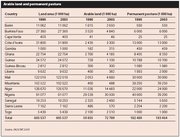Western Africa and land resources
Contents
Introduction State of aridity in Western Africa (Source: CILSS (Western Africa and land resources) 2005)
About 70 percent of Western Africa, covering mainly the Sahelian zone, is semi-arid to desert. The sub-region is experiencing an increase in land degradation caused by salinity, erosion and the loss of soil fertility.
The total land area of the sub-region is 607.84 million hectares (ha). Arable land, permanent pasture and protected areas are shown in the table to the left.
Endowments and opportunities
West Africa is projected to grow economically at about 4.5 percent in 2005, with 8 of the 15 countries expected to record improvements over those achieved in 2004. These are Benin, Burkina Faso, Cape Verde, Côte d’Ivoire, Guinea, Guinea-Bissau, Mali and Senegal. Land resources are the primary driver of this growth. Factors behind this growth include agricultural growth in Benin, Gambia, Guinea, Mali, Senegal, Sierra Leone and Togo; donor support for Guinea-Bissau, Liberia and Sierra Leone; expansion in mining in Burkina Faso, Guinea, Ghana, Mali and Sierra Leone; foreign investment inflows to Cape Verde and Liberia (in response to anticipated improvement in political stability); and growth in tourism in Cape Verde and Gambia.
Agriculture is the main source of revenue of almost 60 percent of the population. The main subsistence and cash crops are maize, rice, coffee, cotton, cocoa, palm oil and fruits. Agricultural income represents an important part of GDP.
In the Sahelian zone, semi-nomadic and domestic livestock production are important activities. However, the long duration of the dry season compels breeders to move their cattle towards the south. This happens in Senegal, Niger, Gambia, Guinea-Bissau, Mali, Mauritania and Burkina Faso.
Regionally, oil has been an important stimulant of growth. The full potential of this for Western Africa is not known. Benin, Ghana, Gambia, Guinea-Bissau, Mali, Niger, Senegal and Togo are all believed to have some oil deposits. Nigeria is the largest oil producer in Africa and the eleventh largest in the world, In 2004, Nigeria’s production averaged 2.5 million barrels per day (bbl/d) and it plans to increase this to 3 million bbl/d in 2006 and to 4 million bbl/d by 2010.
Mining, including for gold, phosphates, iron, uranium and diamonds, offers opportunities for development.
Challenges faced in realizing opportunities for development
Land degradation is the main threat to the opportunities of land for sustainable development. There are several reasons for land degradation in Western Africa: overexploitation, bush fires, and population pressure associated with high population growth rates, to name but few. Land degradation can also be attributed to repeated periods of drought. The immediate effects of the degradation process are erosion, loss in soil fertility, reduction of biodiversity and biomass productivity, and impoverishment of the population.
In the Sahel, overgrazing is another threat to opportunities as it emphasizes land degradation.
Further reading
- CILSS, 2005. Afrique de l’Ouest 3è Rapport sur la mise en oeuvre de la CCD. Comité permanent Inter Etats de Lutte contre la Sécheresse dans le Sahel / Permanent Interstate Committee for Drought Control in the Sahel, Ouagadougou.
- ECA, 2005. Economic Report on Africa 2005: Meeting the Challenges of Unemployment and Poverty in Africa. Economic Commission for Africa, Addis Ababa.
- EIA, 2005b. Country Analysis Briefs: Nigeria Country Analysis Brief. Energy Information Administration.
- FAO, 2005. Food and Agriculture Organization of the United Nations, Rome.
- FAOSTAT – FAO Statistical Databases. Food and Agriculture Organization of the United Nations.
- UNEP, 2006. Africa Environment Outlook 2
|
|
| Disclaimer: This article is taken wholly from, or contains information that was originally published by, the United Nations Environment Programme. Topic editors and authors for the Encyclopedia of Earth may have edited its content or added new information. The use of information from the United Nations Environment Programme should not be construed as support for or endorsement by that organization for any new information added by EoE personnel, or for any editing of the original content. |
